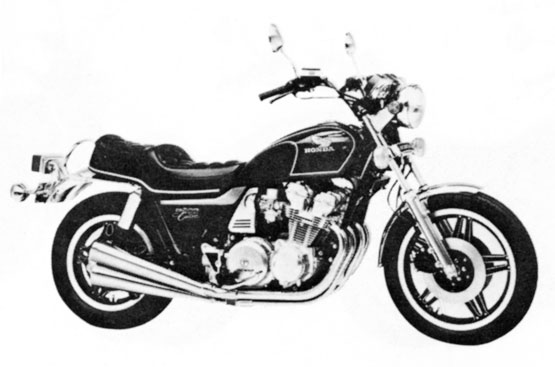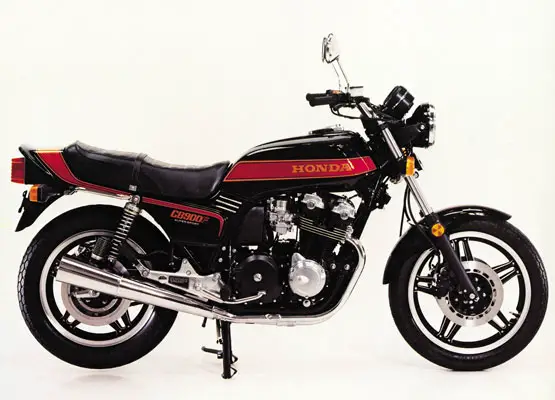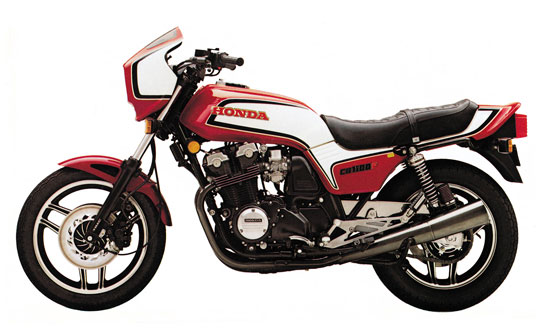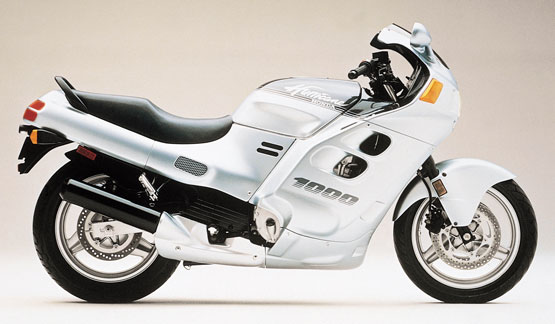Back to the Model History Timeline Review Page
Honda CB’s – 1980-1989 Honda CB900F, CB900C, CB1100F, CBR1000 Hurricane
Page 4 of 7
<< Page Back – Page Forward >>
1980 CB900C: A GOOD IDEA GROWS ON YOU
If a DOHC 749cc engine was a good idea–and the CB750F proved that it was a fine idea indeed–then just imagine how much better that engine could be with 20 percent more displacement! Honda’s engineers didn’t wait around very long; a year after the new 750’s introduction, the CB900C custom made its debut, featuring an enlarged 902cc DOHC engine with four valves per cylinder, plus a dual-range gearbox and shaft drive. Here was a custom cruiser that could perform with the best of the day–bar none.
1981 CB900F: FROM SUPER SPORT TO SUPERBIKE
A strong case can be made for the CB900F’s status as the first Superbike to be shoehorned into a mid-sized package. Springing forth from the CB750F, the CB900F featured a slightly shorter wheelbase and a mere 22.5-pound increase in weight, while boasting a whopping 20 percent increase in displacement. The bored and stroked DOHC 16-valve engine now displaced 902cc, and a lengthy list of upgrades made the 900 a force to be reckoned with: larger valves and carburetors, a stiffer frame made of larger-diameter tubing plus reinforcing gussets, a heftier fork, plus adjustable-damping shocks with external aluminum-body reservoirs.
The CB900F also served as the basis for Honda’s Superbike racing efforts in the capable hands of Freddie Spencer and Mike Baldwin, lending further eyeball appeal and prestige. And perhaps best of all, the suggested retail price of the 900F topped the CB750F’s price tag by a mere $350, making it an irresistible bargain.
1983 CB1100F: SUPERSPORTS GO LARGE
All of the attributes of the CB900F–plus a lot more–applied to the 1983 CB1100F. By punching out the cylinder bores from 64.5 to 70.0mm, the big sporting CB grew to a towering 1062cc in displacement to become the quickest and fastest bike of that era. A new anti-dive system, adjustable handlebars and a new box-section swingarm added to the CB1100F’s prowess while tacking on a trifling 8.5 pounds. It was the apex of engineering refinement for the air-cooled four-cylinder series, and a worthy representative at that. Moreover, once again the CB-F was a bargain-and-a-half, thanks to a mere $200 increase in price over the 1982 CB900F.
1987 CBR1000: A HURRICANE FORCE
When Honda’s four-cylinder CBR®1000 landed in 1987, it truly hit the market with Hurricane® force. A new day dawned as an entire era of air-cooled powerplants yielded to the new wave of liquid-cooled big-inch inline-fours. The CBR’s 998cc DOHC engine featured four valves per cylinder plus liquid cooling for more consistent power, longer engine life, stricter emissions control and quieter operation. It was a complete package brimming with sophistication and refinement–and plenty of performance. This new-generation Big Four was stronger, quicker and faster than its CB1100F predecessor and also lighter–by just a pinch. With great handling, fantastic brakes and sufficient rider amenities to qualify for long-distance work, the Hurricane laid waste to tradition, proving that better is as better does.




